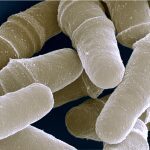Link to Pubmed [PMID] – 20813592
DNA Repair (Amst.) 2010 Oct;9(10):1098-111
Eukaryotic DNA polymerase δ (Pol δ) activity is crucial for chromosome replication and DNA repair and thus, plays an essential role in genome stability. In Saccharomyces cerevisiae, Pol δ is a heterotrimeric complex composed of the catalytic subunit Pol3, the structural B subunit Pol31, and Pol32, an additional auxiliary subunit. Pol3 interacts with Pol31 thanks to its C-terminal domain (CTD) and this interaction is of functional importance both in DNA replication and DNA repair. Interestingly, deletion of the last four C-terminal Pol3 residues, LSKW, in the pol3-ct mutant does not affect DNA replication but leads to defects in homologous recombination and in break-induced replication (BIR) repair pathways. The defect associated with pol3-ct could result from a defective interaction between Pol δ and a protein involved in recombination. However, we show that the LSKW motif is required for the interaction between Pol3 C-terminal end and Pol31. This loss of interaction is relevant in vivo since we found that pol3-ct confers HU sensitivity on its own and synthetic lethality with a POL32 deletion. Moreover, pol3-ct shows genetic interactions, both suppression and synthetic lethality, with POL31 mutant alleles. Structural analyses indicate that the B subunit of Pol δ displays a major conserved region at its surface and that pol31 alleles interacting with pol3-ct, correspond to substitutions of Pol31 amino acids that are situated in this particular region. Superimposition of our Pol31 model on the 3D architecture of the phylogenetically related DNA polymerase α (Pol α) suggests that Pol3 CTD interacts with the conserved region of Pol31, thus providing a molecular basis to understand the defects associated with pol3-ct. Taken together, our data highlight a stringent dependence on Pol δ complex stability in DNA repair.

